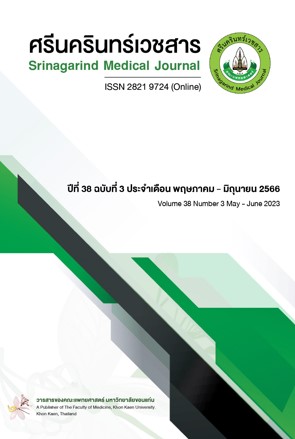Infection Rate of Helicobacter pylori Infected among Fecal Occult Blood Test Positive (Patients) of Annual Physical Examination at Roi Et Hospital
Keywords:
H. pylori infection, Fecal occult blood test, Esophagogastroduodenoscopy, Stomach cancerAbstract
Background and Objective: Helicobacter pylori (H. pylori) infection is associated with peptic ulcer, gastritis, duodenal ulcer as well as the occurrence of gastric cancer. The objective of this study was to investigate the infection rate of H. pylori in those who had fecal occult blood test (FOBT) positive of annual physical examination at Roi Et Hospital.
Method: This study was a retrospective descriptive study. All data were collected from medical records of 235 FOBT positive cases who attended an annual physical examination at Roi Et Hospital between 1 January 2020 and 31 December 2022. All of them were FOBT positive, underwent with esophagogastroduodenoscopy (EGD), and positive for H. pylori infection by Rapid urease test. Descriptive statistics were used for all data analysis.
Results: All of 235 cases underwent with EGD, most of them were female 56.17%, mean age 54.22 years. Hypertension was major underlying disease (23.40%). The EGD examination revealed that upper gastrointestinal abnormal 98.29% (231 cases), gastritis 77.87%, gastric polyp 6.81%, hemorrhagic gastritis 4.68%, hiatal hernia 2.55%, and duodenitis 2.13%. The H. pylori rapid urease tests were positive in 228 cases (97.02%). All cases with H. pylori infection were treated.
Conclusion: This study found the infection rate of H. pylori infected was 97.02 % and the EGD examination found out that upper gastrointestinal abnormality was 98.29%. All cases with H. pylori infection and upper gastrointestinal abnormalities were treated.
References
Alfarouk OK, Adil HH. Bashir HHA, Ahmed N. Aljarbou NA, Ramadan MA, Muddathi KAr, AlHoufie TS, et al . The possible role of Helicobacter pylori in gastric cancer and its management. Front Oncol 2019; 9(75):1-12. doi.org/10.3389/fonc.2019.00075
Gravina AG, Zagari RM, De Musis C, Romano L, Loguercio C, Romano M. Helicobacter pylori and extragastric diseases: A review. World J Gastroenterol 2018;24(29):3204–21. doi.org/10.3748/wjg.v24.i29.3204
Ford AC, Axon ATR. Epidemiology of Helicobacter pylori infection and public health implications. Helicobacter 2010;15(Suppl 1):1–6. doi.org/10.1111/j.1523-5378.2010.00779.x
Tongtawee T, Kaewpitoon S, Kaewpitoon N, Dechsukhum C, Leeanansaksiri W, Loyd RA, et al. Diagnosis of Helicobacter pylori Infection. Asian Pac J Cancer Prev APJCP 2016;17(4):1631–5. doi.org/10.7314/APJCP.2016.17.4.1631
Zamani M, Vahedi A, Maghdouri Z, Shokri-Shirvani J. Role of food in environmental transmission of Helicobacter pylori. Casp J Intern Med 2017;8(3):146–52.
van Duynhoven YT, de Jonge R. Transmission of Helicobacter pylori: a role for food? Bull World Health Organ 2001;79(5):455–60.
Salih BA. Helicobacter pylori infection in developing countries: the burden for how long? Saudi J Gastroenterol Off J Saudi Gastroenterol Assoc 2009;15(3):201–7. doi.org/10.4103/1319-3767.54743
Camilo V, Sugiyama T, Touati E. Pathogenesis of Helicobacter pylori infection. Helicobacter 2017;22(Suppl 1):. doi.org/10.1111/hel.12405.
Waskito LA, Salama NR, Yamaoka Y. Pathogenesis of Helicobacter pylori infection. Helicobacter 2018;23(Suppl 1):e12516. doi.org/10.1111/hel.12516
Eusebi LH, Zagari RM, Bazzoli F. Epidemiology of Helicobacter pylori infection. Helicobacter 2014;19(Suppl 1):1–5. doi.org/10.1111/hel.12165
Mentis A, Lehours P, Mégraud F. Epidemiology and Diagnosis of Helicobacter pylori infection. Helicobacter 2015;20(Suppl 1):1–7. doi.org/10.1111/hel.12250
Deankanob W, Chomvarin C, Hahnvajanawong C, Intapan PM, Wongwajana S, Mairiang P, et al. Enzyme-linked immunosorbent assay for serodiagnosis of Helicobacter pylori in dyspeptic patients and volunteer blood donors. Southeast Asian J Trop Med Public Health 2006;37(5):958–65.
Hooi JKY, Lai WY, Ng WK, Suen MMY, Underwood FE, Tanyingoh D, et al. Global prevalence of helicobacter pylori infection: systematic review and meta-analysis. Gastroenterology 2017;153(2):420–9. doi.org/10.1053/j.gastro.2017.04.022
Shoosanglertwijit R, Kamrat N, Werawatganon D, Chatsuwan T, Chaithongrat S, Rerknimitr R. Real-world data of Helicobacter pylori prevalence, eradication regimens, and antibiotic resistance in Thailand, 2013-2018. JGH Open Open Access J Gastroenterol Hepatol 2020;4(1):49–53. doi.org/10.1002/jgh3.12208
Fock KM, Ang TL. Epidemiology of Helicobacter pylori infection and gastric cancer in Asia. J Gastroenterol Hepatol 2010;25(3):479–86. doi.org/10.1111/j.1440-1746.2009.06188.x
Suzuki R, Shiota S, Yamaoka Y. Molecular epidemiology, population genetics, and pathogenic role of Helicobacter pylori. Infect Genet Evol J Mol Epidemiol Evol Genet Infect Dis 2012;12(2):203–13. doi.org/10.1016/j.meegid.2011.12.002
Vilaichone RK, Mahachai V, Graham DY. Helicobacter pylori diagnosis and management. Gastroenterol Clin North Am 2006;35(2):229–47. doi.org/10.1016/j.gtc.2006.03.004
Ford AC, Forman D, Hunt RH, Yuan Y, Moayyedi P. Helicobacter pylori eradication therapy to prevent gastric cancer in healthy asymptomatic infected individuals: systematic review and meta-analysis of randomised controlled trials. BMJ 2014;348:g3174. doi.org/10.1136/bmj.g3174
Mahachai V, Vilaichone RK, Pittayanon R, Rojborwonwitaya J, Leelakusolvong S, Maneerattanaporn M, et al. Helicobacter pylori management in ASEAN: The Bangkok consensus report. J Gastroenterol Hepatol 2018;33(1):37–56. doi.org/10.1111/jgh.13911
Thong-Ngam D, Tangkijvanich P, Mahachai V, Kullavanijaya P. Current status of gastric cancer in Thai patients. J Med Assoc Thail 2001;84(4):475–82.
Suwanrungruang K, Sriamporn S, Wiangnon S, Rangsrikajee D, Sookprasert A, Thipsuntornsak N, et al. Lifestyle-related risk factors for stomach cancer in northeast Thailand. Asian Pac J Cancer Prev 2008;9(1):71–5.
Subsomwong P, Miftahussurur M, Uchida T, Vilaichone RK, Ratanachu-Ek T, Mahachai V, et al. Prevalence, risk factors, and virulence genes of Helicobacter pylori among dyspeptic patients in two different gastric cancer risk regions of Thailand. PloS One 2017;12(10):e0187113. doi.org/10.1371/journal.pone.0187113
Uchida T, Miftahussurur M, Pittayanon R, Vilaichone R korn, Wisedopas N, Ratanachu-ek T, et al. Helicobacter pylori Infection in Thailand: A Nationwide Study of the CagA Phenotype. PLoS ONE 2015;10(9):e0136775. doi.org/10.1371/journal.pone.0136775
Zamani M, Ebrahimtabar F, Zamani V, Miller WH, Alizadeh-Navaei R, Shokri-Shirvani J, et al. Systematic review with meta-analysis: the worldwide prevalence of Helicobacter pylori infection. Aliment Pharmacol Ther 2018;47(7):868–76. doi.org/10.1111/apt.14561
Downloads
Published
How to Cite
Issue
Section
License
Copyright (c) 2023 Srinagarind Medical Journal

This work is licensed under a Creative Commons Attribution-NonCommercial-NoDerivatives 4.0 International License.




